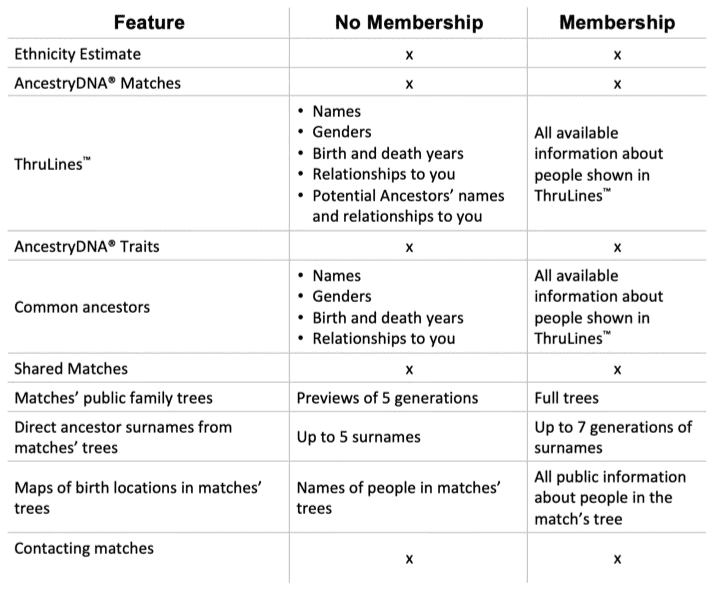
There are now 3 scenarios Ancestry can generate.ġ. We both have the exact same names in our tree. The other member is on my DNA match list. So let’s take two trees-one from me and one from another member. 25 April 2020 - Noted at the top that these features are no longer in beta testing and do not require an opt-in.If you want to opt out, click on Extras in your black toolbar at the top of the Ancestry window, then select Ancestry Lab. If you have taken an AncestryDNA test, you can opt into the new and improved DNA Matches features here. I love the updated Match List! I’d love it even more if we could automatically color tag all of the matches shared with a particular person, rather than having to tag each one individually.īeing able to edit the notes from the match list would also be really nice. You can zoom in to view individual matches. It gives a scalable world map with pins showing the geographic locations of your DNA matches. There are other filters, as well, with other options, to give you flexibility and control over your match list.Īt the top of the main match page is an intriguing link. Then, the groups can be filtered to simplify the work of finding connections. It’s like a quick and easy Leeds method, fully integrated into your AncestryDNA match list.

MY DNA MATCHES NO FAMILY NAME IN COMMON CODE
An adoptee might name their first group after their top match, color code that set of shared matches, then go down the match list doing the same with the next ungrouped match. Groups needn’t be known surnames, of course. I can select any one of them to filter my match list down to just that line. These are my color tags (my eight great grandparents). Why? Because the color tags can act as filters! There, I can easily color code them as all being related to my son through Thomas Patrick Larkin and Deedee Weicks, his 2-great grandparents.Ĭolor tagging Shared Matches will be especially helpful for anyone working on a mystery line, be it an unknown parent or an unknown great grandparent. Next is a short list of Shared Matches, and down below (not shown) is a comparison of ethnicity estimates.Ĭlicking on the green “View all shared matches” button pulls up the list of all shared matches between my son and Anna. This is my father’s first cousin compared with my son.īecause both I and Anna have trees, the system is able to identify the Common Ancestors (formerly called Shared Ancestor Hints) between her and my son. I can click on a relative in the match list to get a comparison page. That will pull up the edit screen shown above. If you want to change the name or color of a group, click “Add/edit groups” for any match then the grey pencil icon beside the group in question. The most I’ve tried is eight so far, one color for each of my own great grandparents. There are 24 colors available (24!), and as far as I know, you can add them all to a single match. Colors that have already been assigned to a different group will have a horizontal slash through them, like the rose dot below. Name your group, select a color, then click the green Save button. Click the blue “Add to group” link to get started.


Perhaps the most exciting and visually appealing addition to the DNA Matches page are customizable color tags.
MY DNA MATCHES NO FAMILY NAME IN COMMON FULL
Looks l like AncestryDNA is making use of the fully-identical regions that full siblings share. Previously, this category was called “Immediate Family”, which confused many people. The astute among you may notice that his sister is in a category called “Full Sibling”. When you are able to test parents, though, this is a great timesaver.Īlso on the right-hand side of the screen, notice that his matches have notes visible (Mom, Dad, etc.) Those notes, added on the individual match pages, can now be seen in the match list without a third-party extension, again making it easier to quickly screen your DNA relatives. That’s because both of his parents have tested at AncestryDNA if you can only test one parent, only matches on their side will be labeled, and if you can’t test either parent, unfortunately this feature will not work for you. The first thing you might notice is that my son’s matches are automatically flagged as “Mother’s Side” and “Father’s Side”. The screenshot below shows my son’s top DNA matches (me and his dad, his sister, and three of his four grandparents). There are other exciting changes, as well. The list of relatives is now more compact, so you can screen more at once. These features are now available to all users of AncestryDNA and no longer require opting into “beta testing”.įor RootsTech 2019, AncestryDNA is introducing a new and improved DNA Matches page, along with other exciting features ( MyTreeTags and ThruLines).


 0 kommentar(er)
0 kommentar(er)
